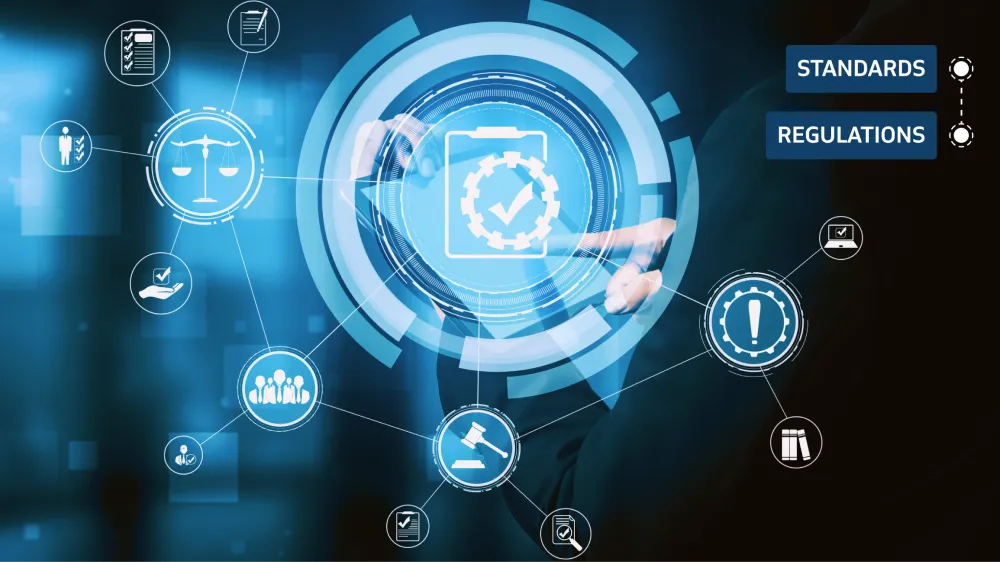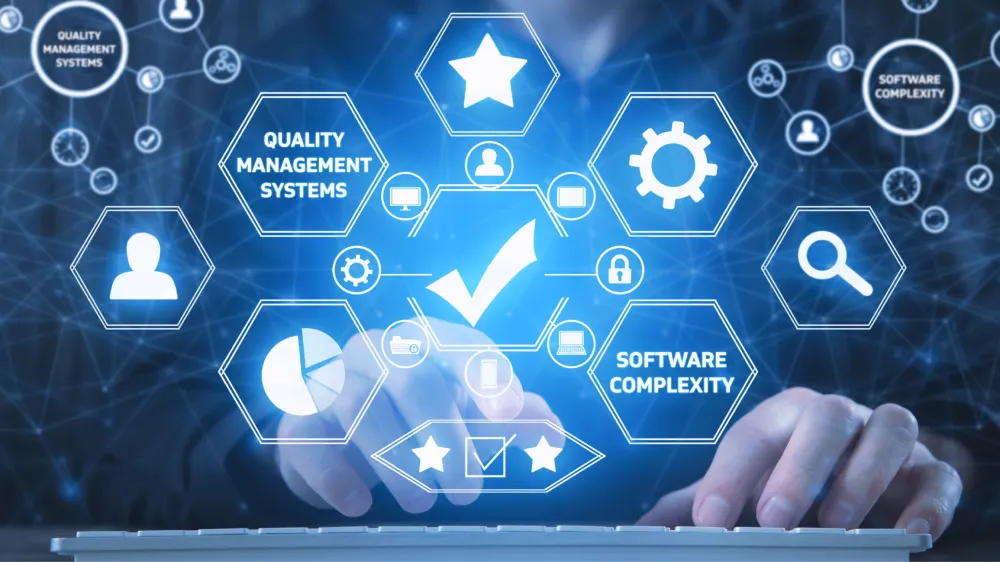Medical device software plays a vital role in modern healthcare, directly influencing patient diagnosis, monitoring, and treatment. In 2023, the medical device software market reached $24.29 billion and is projected to grow to $30.4 billion by 2024, with a 25.2% CAGR.
With the global healthcare technology market rapidly expanding, the demand for robust software validation is more critical than ever. Medical device software validation involves a detailed process to ensure that the software meets x regulatory standards and performs as intended.
This blog delves into why medical device software validation is crucial for safety and compliance and outlines the validation process.
What is Medical Device Software Validation?
Medical device software verification is a critical process that ensures design outputs adhere to the required specifications throughout every stage of development. Program verification assesses the software’s accuracy, consistency, and completeness, ensuring that supporting documentation is in order.
The process confirms compliance with necessary standards through testing and review. Additional verification methods include static and dynamic analysis, code inspections, and walkthroughs. These verification methods work together to provide a thorough assessment of the software, ensuring that it not only meets design specifications but also operates reliably and effectively in real-world applications.
Why is Medical Device Software Validation Important?
Validating medical device software is crucial for ensuring patient safety and minimizing risks. Unvalidated software can lead to inaccurate readings, device malfunctions, data breaches, and even life-threatening events. For instance, there have been instances where insufficiently validated blood glucose monitoring systems led to incorrect insulin dosages. Such errors not only compromised patient health but also underscored the critical importance of robust validation procedures in preventing severe health complications.

Through a comprehensive validation process, potential issues can be identified and resolved before they impact patients, enhancing the software’s reliability and safety. Additionally, medical device software validation also ensures interoperability in connected healthcare systems, guaranteeing accurate communication and reducing treatment errors that can arise from miscommunication or incompatible systems, ultimately contributing to improved patient outcomes and more efficient healthcare delivery.
Step-by-step Guide to Medical Device Software Validation
Software validation is crucial for ensuring that medical device software meets its intended purpose. For those new to medical device software or seeking a streamlined approach to regulatory compliance, here are five key steps to ensure successful validation:
- Define a software validation plan
- Establish your system prerequisites
- Establish a validation protocol and test guidelines
- Perform and record tests
- Refine processes and document your final report

Define a software validation plan
Defining a software validation plan is the first step in the validation process, providing detailed documentation that outlines the software system and its operating environment. The plan needs to identify project assumptions, limitations, test acceptance criteria, validation procedures, and the roles and responsibilities of the validation team. Serving as a blueprint for the entire software validation process, the plan guides all validation activities.
Though the plan may evolve as the project progresses, any modifications must be thoroughly documented to ensure transparency and accuracy throughout the validation lifecycle.
Establish your system prerequisites
Building your system prerequisites involves defining the necessary conditions for the software to perform as expected. These prerequisites include infrastructure elements such as staffing, facilities, and equipment, along with functional requirements like performance, security, system interfaces, and operating environment.
In addition, the system prerequisites may encompass a risk analysis to identify potential gaps in the functional requirements, ensuring the system is thoroughly prepared for its intended use.
Establish a validation protocol and test guidelines
Establishing a validation protocol and test guidelines requires defining the software’s expected performance and proving its functionality. A comprehensive test plan should outline the objectives and methods for testing and verifying the medical device software.
Test cases must be created to simulate typical scenarios, ensuring the software can handle critical business processes or produce regulated products. The goal is to proactively uncover potential errors and verify that key features operate as intended.
Perform and record tests
Once testing begins, perform and record all tests by documenting outcomes, including successes, failures, and any errors encountered. Each test case should be linked to its relevant requirement to ensure full traceability.
Any identified issues must be logged, analyzed, and addressed with corrective actions to resolve defects or discrepancies. Detailed documentation is crucial as it supports regulatory compliance and future audits.
Refine processes and document your final report
Finally, refining processes and documenting the final report involve developing and building procedures for using the software after testing. The final validation report must be written, reviewed, and approved before system release. This report should cover essential details, including support, training, security backup, and recovery plans.
Standards and Regulations for Medical Device Software Validation
Ensuring compliance with international standards and regulatory requirements is crucial for the successful validation of medical device software. Adhering to these standards and regulations helps ensure that software meets safety, performance, and quality criteria.

International standards
- ISO 13485: Defines the requirements for a quality management system specific to medical devices, including the processes needed for software validation.
- IEC 62304: Outlines the lifecycle processes for medical device software, including requirements for software development, maintenance, and validation to ensure software safety and effectiveness.
- ISO 14971: Provides guidelines for applying risk management to medical devices, including methods for assessing and mitigating risks associated with software.
- IEC 60601-1: Establishes general safety and performance requirements for medical electrical equipment, including considerations for software validation to ensure device safety.
Regulations
- FDA (U.S. Food and Drug Administration): Provides specific guidance documents for software validation, such as the “General Principles of Software Validation,” which outlines the process for validating software used in medical devices, and “Software as a Medical Device (SaMD),” which details requirements for software functioning as a standalone medical device.
- EMA (European Medicines Agency): Offers regulations and guidelines for medical device software within the European Union, including standards for software validation and compliance with medical device directives.
Overcoming Challenges in Medical Device Software Validation
Addressing the challenges of medical device software validation involves understanding complex regulations, managing software intricacies, and adhering to quality management systems. Here’s how to tackle these issues effectively with expert solutions.

Staying Compliant with Quality Management Systems
A key challenge in medical device software validation is ensuring your software meets strict Quality Management System (QMS) standards. QMS covers everything from documentation to process traceability, requiring constant oversight to stay compliant. Meeting these high standards can feel overwhelming, especially when you’re also trying to innovate and move fast.
However, with a structured approach, you can keep things on track. Clear, organized documentation helps you maintain compliance while reducing errors. Automation tools can also be a game-changer, making it easier to streamline testing and compliance checks. Regular audits, internal reviews, and keeping your team up-to-date with QMS requirements will help ensure you’re meeting all necessary standards without slowing down development.
Managing Software Complexity
Software complexity is a major challenge, especially when integrating multiple systems while meeting various stakeholders’ needs. Overlapping regulations and QMS requirements can add further complications, increasing the burden on developers and affecting the final product.
To tackle this, it’s crucial to develop a strategic roadmap that helps you manage this complexity and ensure smooth integration between systems. Aligning your processes with the necessary regulations simplifies things, reducing the burden on your team. And by regularly reviewing and updating your roadmap, you can make sure your project stays on track, even as new challenges or regulations arise.
FAQs

- What distinguishes medical device validation from software verification?
Validation ensures the product addresses customer needs and resolves the intended problem, emphasizing its usefulness. It answers the question, “Are we building the right product?” On the other hand, verification confirms that the software is correctly engineered, error-free, and meets specified requirements, focusing on quality.
- How much does it cost to get a device FDA-approved?
The cost of getting a device FDA-approved typically ranges between $20,000 and $30,000 for preparation and review before a 510(k) submission, assuming prior approval in another major country with a regulatory authority. For new products that haven’t been approved elsewhere, costs rise significantly due to the need for extensive testing on factors such as usage, performance, and safety.
Enhance Medical Device Software Validation Success with KMS Healthcare
As medical device software evolves, staying ahead with innovative solutions is crucial for ensuring safety, compliance, and market success. KMS Healthcare provides specialized testing services to support and enhance your medical device software development, including:
- Regulatory Compliance Assurance: Validate that your software meets all necessary regulatory standards.
- Quality & Market Readiness Assessment: Evaluate and enhance your product’s quality and readiness for market entry.
- Testing Strategies & Processes: Establish robust testing strategies to validate your software and ensure reliability.
Ready to elevate your medical device software development? Discover how KMS Healthcare’s expertise can drive your success in the healthcare technology landscape. Get in touch with us now!
